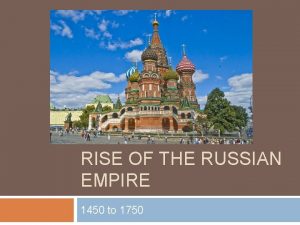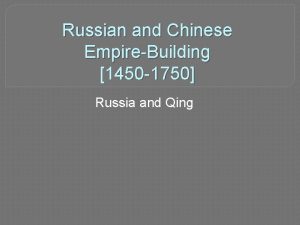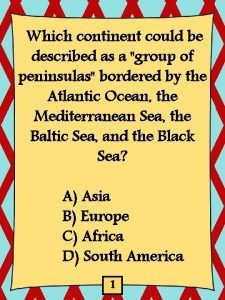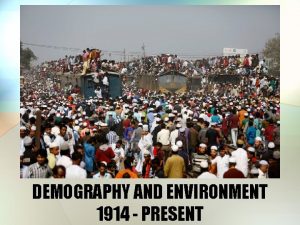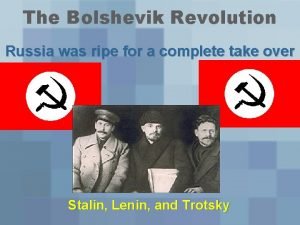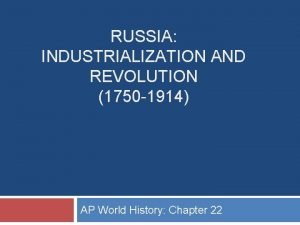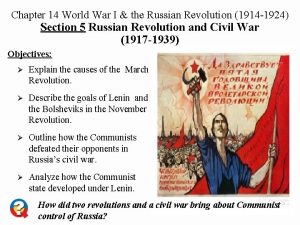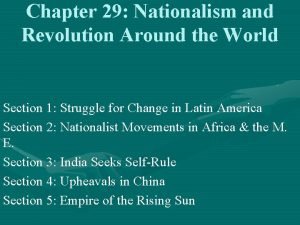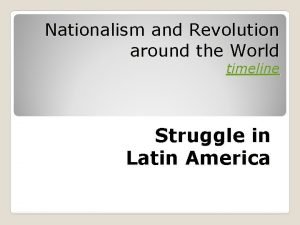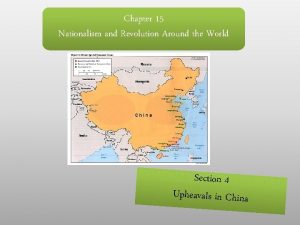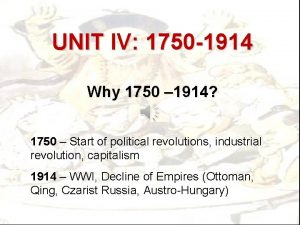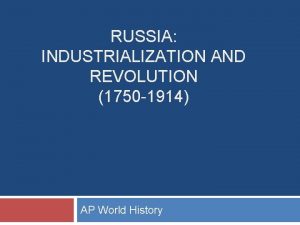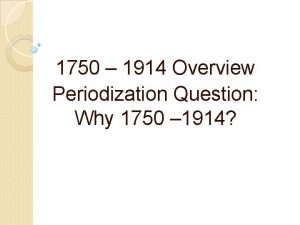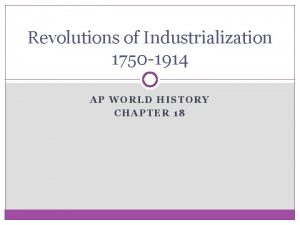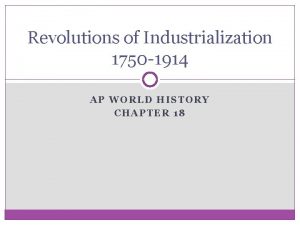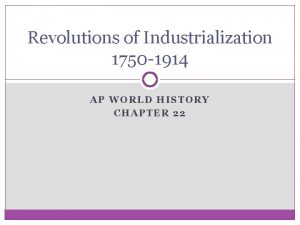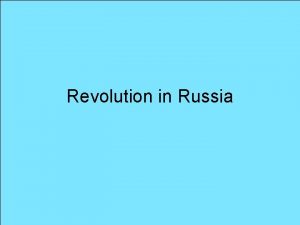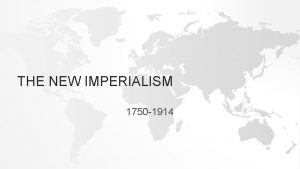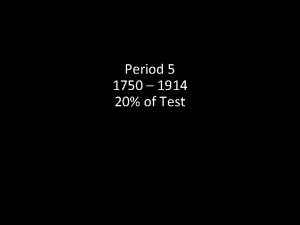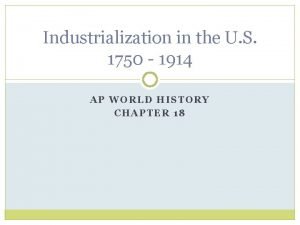RUSSIA INDUSTRIALIZATION AND REVOLUTION 1750 1914 AP World
















- Slides: 16

RUSSIA: INDUSTRIALIZATION AND REVOLUTION (1750 -1914) AP World History: Chapter 18

Russia During the 19 th Century STILL had an absolute monarchy (the tsar) No national parliament No political parties No nationwide elections Russian society = dominated by titled nobility Until 1861 = most Russians were serfs � Bound to their masters’ estates; subject to sale; greatly exploited Tsar Nicholas I (1825 -1855)

Russia: “Transformation from Above” In the U. S. = social and economic change has always come from society as people sought new opportunities and rights In Russia = change was initiated by the state/government itself � Done to catch up with the more powerful and innovative states of western Europe

Russia: “Transformation from Above” Peter the Great (1689 -1725) Enlarged and modernized the military � Created new educational system for sons of nobles � Supported new manufacturing enterprises � Nobles had to dress in European styles � New capital = St. Petersburg = “window on the West” � Catherine the Great (17621796) � Russia’s “heir to the Enlightenment”

Russia: “Transformation from Above” 1861 = Russian state abolished serfdom (by Alexander II) Stimulated by its defeat in the Crimean War (1854 -1856) � Lost to British and French forces � War was over influence in territories of the declining Ottoman Empire � Tsar Alexander II saw the defeat of Russia’s serf-army at the hands of FREE British and French troops as a sign to end serfdom After the abolition of serfdom = Russia began a program of industrial development

Russia’s Industrial Revolution 1890 s = industrialization under way and growing rapidly Focused on railroads and heavy industry By 1900 = Russia ranked 4 th in the world in steel production Had major industries in: coal, textiles, and oil

Social Outcomes: The Middle Class A Family at Table, 1938 Painting of a Middle-Class Russian Family Growing middle class = comprised of businessmen and professionals Many objected to tsarist Russia and wanted a greater role in political life But, the middle class was also dependent on the state for: contracts, jobs, and suppressing the

Social Outcomes: The Working Class Factory workers = about 5% of total Russian population Harsh work conditions � 13 -hour work day � Ruthless discipline and constant disrespect from supervisors Most lived in large, unsanitary barracks Unions and political parties = illegal � Only way to protest was through large-scale strikes

Social Outcomes: The Working Class Many workers and educated Russians turned to Marxist socialism 1898 = illegal Russian Social-Democratic Labor Party created � Got involved in: workers’ education, union organizing, and revolutionary action 1905 = a revolution in Russia erupted

Russian Revolution of 1905 Erupted following a Russian defeat in a naval war with Japan Workers went on strike and created their own representative councils called soviets Revolution also included: peasant uprisings, mutinies in the military, student demonstrations, and revolts of non-Russian nationalities The Russo-Japanese War (1905) occurred as a result of imperialist competition over Manchuria and Korea

Russian Revolution of 1905

Russian Revolution of 1905 Revolution was brutally suppressed and pretty unsuccessful As a result of the revolution, the tsar’s regime implemented some reluctant and halfhearted reforms (most of which weren’t actually carried out) Granted a constitution � Legalized trade unions and political parties � Permitted election of a national assembly (the Duma) � Censorship eased � Plans for universal primary education � Continued industrial development �

After the 1905 Revolution These limited reforms did not tame the radical working class or bring social stability to Russia 1907 = Tsar Nicholas II dissolved the Duma Limited political voice even for the privileged classes Many felt that revolution was inevitable and necessary if real changes were going to happen Russian Duma in 1906

Growth of Revolutionary Groups Most of these groups were socialist Most effective in the cities Published pamphlets and newspapers Organized trade unions Spread their messages among workers and peasants Furnished leaders who were able to act when the

The Revolutionary Moment Key catalyst = World War I Russian Revolution of 1917 sparked by: � Hardships of WWI � Social tensions of industrialization � Autocratic tsarist regime This revolution brought to power the Bolsheviks = radical socialist group � Led by Vladimir Lenin

Only in Russia… Industrialization caused violent social revolution A socialist party, inspired by Karl Marx, was able to seize power Modern world’s first socialist society
 Russian empire 1450
Russian empire 1450 St basil's cathedral ap world history
St basil's cathedral ap world history Which letter represents the rhine river?
Which letter represents the rhine river? Pstuffy bunny
Pstuffy bunny Population of the world 1914
Population of the world 1914 Why was russia ripe for revolution ww1
Why was russia ripe for revolution ww1 Russian revolution of 1917 definition ap world history
Russian revolution of 1917 definition ap world history Mongols in russia ap world history
Mongols in russia ap world history Russian revolution vs french revolution
Russian revolution vs french revolution You should hope this game will be over soon
You should hope this game will be over soon Third agricultural revolution definition
Third agricultural revolution definition World war 1 and the russian revolution chapter 27
World war 1 and the russian revolution chapter 27 Kzbho6asboc -site:youtube.com
Kzbho6asboc -site:youtube.com Chapter 29: nationalism around the world answers
Chapter 29: nationalism around the world answers When did mao take over china
When did mao take over china Nationalism and revolution around the world
Nationalism and revolution around the world Nationalism and revolution around the world
Nationalism and revolution around the world
